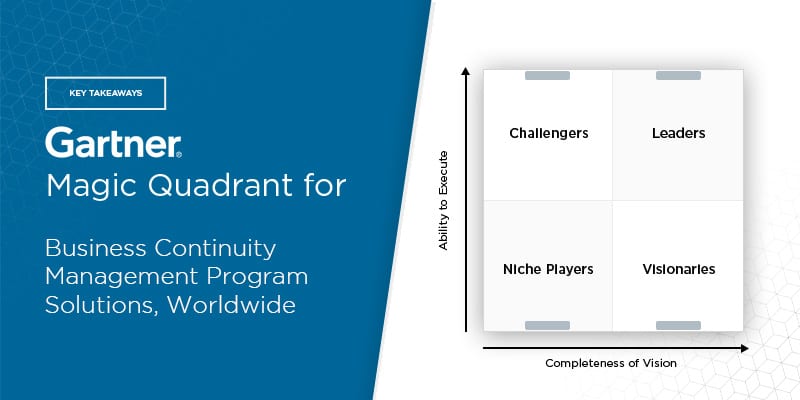2019 Gartner Magic Quadrant for Business Continuity Management Program Solutions, Worldwide: Key Takeaways

 Analyst house Gartner, Inc. recently released its 2019 Magic Quadrant for Business Continuity Management Program Solutions, Worldwide. Gartner defines Business Continuity Management Program (BCMP) solutions as “the primary tools used to manage BCM programs through all phases of the business continuity management (BCM) life cycle, including planning and execution.” Gartner changed the market name from BCM planning solutions to BCM program solutions in 2019. This change was implemented to better reflect the full capabilities of the solutions offered in supporting full organizational resilience.
Analyst house Gartner, Inc. recently released its 2019 Magic Quadrant for Business Continuity Management Program Solutions, Worldwide. Gartner defines Business Continuity Management Program (BCMP) solutions as “the primary tools used to manage BCM programs through all phases of the business continuity management (BCM) life cycle, including planning and execution.” Gartner changed the market name from BCM planning solutions to BCM program solutions in 2019. This change was implemented to better reflect the full capabilities of the solutions offered in supporting full organizational resilience.
BCMP offers capabilities for risk assessment for availability, Business Impact Analysis (BIA), dependency mapping, IT disaster recovery management, plan management, what-if modeling, exercise delivery, crisis management, and program management metrics and analysis. BCMPs must demonstrate maturity, status, and effectiveness on an ongoing basis, rather than just once a year. However, the best BCMPs have prebuilt or configured BCM functionality out of the box, instead of building BCMP functionality with each customer implementation.
In this Magic Quadrant, Gartner evaluates the strengths and weaknesses of 15 providers that it considers most significant in the marketplace, and provides readers with a graph (the Magic Quadrant) plotting the vendors based on their ability to execute and their completeness of vision. The graph is divided into four quadrants: niche players, challengers, visionaries, and leaders. At Solutions Review, we read the report, available here, and pulled out the key takeaways.
This year’s Magic Quadrant features five new vendors, namely, Galvanize, Assurance, BC in the Cloud, Grey Wall, and Premier Continuum. Following ACL’s acquisition of Rsam, ACL and Rsam announced that they have been rebranded as Galvanize. Additionally, new vendor, Assurance supports all key elements of the BCM life cycle and is closely aligned to ISO 22301 and NFPA 1600. BC in the Cloud’s (BCIC) addition to this year’s Magic Quadrant is likely due to its crisis management capability, which has a real-time clock with impacts aggregated over time. Grey Wall Software’s new status on the graph is possibly because of its high customer satisfaction ratings from Gartner. Finally the addition of Premier Continuum likely results from its implementation tools being configurable by the client, as well as adaptable to the organization’s strategic goals.
This year’s Magic Quadrant only has vendors placed in the challenger and leader sections, with the leader quadrant being especially crowded, with 12 providers. BC in the Cloud, Galvanize, and Fairchild Resiliency Systems are the only challengers this year. Fairchild Resiliency Systems is close to the vertical axis of the graph, showing its completeness of vision. This placement is possibly due to the fact that its solution’s user interface can be modified, and fields can be added or deleted as needed.
This year’s leaders are Grey Wall Software, ClearView, Premier Continuum, RecoveryPlanner, Dell Technologies (RSA), Lockpath, MetricStream, Continuity Logic, SAI Global, Assurance Software, Avalution Consulting, and Fusion Risk Management. Fusion Risk Management received the highest ability to execute, with its IT disaster recovery management functionality named the best of the report this year by Gartner. Avalution Consulting was placed just below Fusion and was praised for its adaptable solution with easy integration and full report generation and dashboarding.
Also in the leader category is ClearView, placed in very close competition with Premier Continuum. ClearView offers a platform that has an all-inclusive packaged license with all capabilities enabled for all of its clients. RecoveryPlanner was also placed near ClearView, losing out slightly on its ability to execute. This is possibly due to the fact that the company’s solution still needs to develop in terms of sophistication. Slightly closer to the vertical axis of the graph is Lockpath, which likely scored lower on completeness of vision because implementing the solution is reportedly somewhat difficult.
Rounding out the leader category are MetricStream, Continuity Logic, Dell Technologies, and SAI Global. MetricStream gained leader distinction as a result of its responsive web design and crisis management capability. Continuity Logic, placed on the lower end of this quadrant, does not automatically include plan migration into its implementation, but its solution is available on all smart devices. Dell Technologies (RSA), placed slightly above Continuity Logic, boasts one of the most comprehensive customer training programs for implementation processes, and courses on business resiliency and audit management. Finally, SAI Global distinguishes itself from its competitors through its user interface, which delivers visualizations and dashboards built into each screen, as well as the user homepage that is controlled by access controls.
Gartner also included Resolver as a vendor to watch. Though the provider did not meet one or more of Gartner’s inclusion criteria, it represents vendors that are innovative in technology or delivery models.
Read Gartner’s Magic Quadrant for Business Continuity Management Program Solutions, Worldwide.
Looking for more? Consider downloading our free Backup and Disaster Recovery Buyer’s Guide to compare the top products available on the market with full page vendor profiles, questions to ask before purchasing, our bottom line analysis, and more. If you’re on the lookout for other data protection resources, check out our Disaster Recovery as a Service Buyer’s Guide and our Data Protection Vendor Map for more!
























